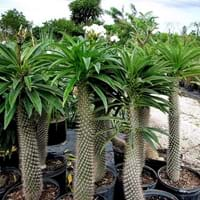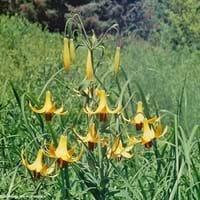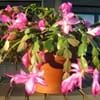Life Span
Perennial
Perennial
Type
Cactus or Succulent, Ornamental Plants, Perennial
Bulb or Corm or Tuber
Origin
Madagascar
Hybrid origin, North America, Europe, Africa, Asia
Types
P. ambongense P. baronii P. bicolor P. bispinosum P. brevicaule P. cactipes P. decaryi P. densiflorum P. eburneum P. geayi P. gracilius
Tiger lily, Columbia lily, Woody lily
Habitat
Rocky areas, Tropical areas
meadows, Shady Edge, Woods
USDA Hardiness Zone
9-12
2-8
Sunset Zone
H1, H2, 13, 21, 22, 23, 24
21,22
Habit
Upright/Erect
Upright/Erect
Flower Color
White
White, Yellow, Red, Green, Purple, Gold, Pink, Rose, Peach, Burgundy, Bronze
Flower Color Modifier
Not Available
Bicolor
Fruit Color
Gray Green, Tan
Yellow green, Sandy Brown
Leaf Color in Spring
Green, Dark Green
Green, Dark Green
Leaf Color in Summer
Green, Dark Green
Light Green
Leaf Color in Fall
Dark Green
Several shades of Green
Leaf Color in Winter
Not Available
Light Green
Leaf Shape
Long Narrow
Long Narrow
Plant Season
Spring, Summer, Fall, Winter
Spring, Summer, Fall
Sunlight
Full Sun
Full Sun, Partial Sun, Partial shade
Growth Rate
Medium
Medium
Type of Soil
Sand
Clay, Loam, Sand
The pH of Soil
Acidic, Neutral, Alkaline
Acidic, Neutral, Alkaline
Soil Drainage
Well drained
Well drained
Bloom Time
Late Spring, Early Summer, Summer
Not Available
Tolerances
Drought
Drought
Where to Plant?
Container, Ground, Pot
Container, Ground
How to Plant?
Seedlings, Stem Cutting
From bulbs, Seedlings, Transplanting
Plant Maintenance
Medium
Medium
Watering Requirements
Drought Tolerant, Reduce watering in winter
Average Water Needs, Never Over-water, Requires regular watering
In Summer
Lots of watering
Lots of watering
In Spring
Moderate
Moderate
In Winter
Average Water
Average Water
Soil pH
Acidic, Neutral, Alkaline
Acidic, Neutral, Alkaline
Soil Type
Loam, Moist, Sand, Well drained
Clay, Loam, Sand
Soil Drainage Capacity
Well drained
Well drained
Sun Exposure
Full Sun
Full Sun, Partial Sun, Partial shade
Pruning
Prune in winter, Prune to stimulate growth, Remove damaged leaves, Remove dead branches, Remove dead leaves
Remove damaged leaves, Remove dead leaves, Remove dead or diseased plant parts
Fertilizers
All-Purpose Liquid Fertilizer, Fertilize in early spring, fertilize in early summer
All-Purpose Liquid Fertilizer
Pests and Diseases
Aphids, Dry root rot
Red blotch
Plant Tolerance
Drought
Drought
Flower Petal Number
Single
Single
Fragrant Bark/Stem
Not Available
No
Foliage Texture
Bold
Not Available
Foliage Sheen
Glossy
Not Available
Attracts
Not Available
Deers, Insects, Moths
Allergy
poisonous if ingested, Toxic
Headache
Aesthetic Uses
along a porch, deck or patio, Beautification, Borders, Showy Purposes
Beautification, Bouquets, Landscape Designing, Showy Purposes
Beauty Benefits
Not Available
Not Available
Edible Uses
Not Available
Yes
Environmental Uses
Air purification
Air purification
Medicinal Uses
Not Available
Cough, Fever, Menstrual Disorders, Stomach pain, tuberculosis, Upset stomach, Wounds
Part of Plant Used
Not Applicable
Bulbs, Flowers, Root, Seeds
Other Uses
Decoration Purposes, Showy Purposes
Can be made into a herbal tea, Employed in herbal medicine, Used As Food
Used As Indoor Plant
Sometimes
Yes
Used As Outdoor Plant
Yes
Yes
Garden Design
Container, Feature Plant, Mixed Border, Rock Garden, Wall, Tropical
Alpine, Container, Cutflower, Feature Plant, Mixed Border, Wildflower
Botanical Name
PACHYPODIUM lamerei
LILIUM canadense
Common Name
Madagascar Palm, Club Foot
Meadow lily
In Hindi
Madagascar palm
कनाडा लिली
In German
Madagaskarpalme
Kanada Lily
In French
Pachypodium de Madagascar
Lily Canada
In Spanish
Palma de Madagascar
Kanada Lily
In Greek
Pachypodium
Kanada Lily
In Portuguese
Palmeirinha-de-madagáscar, Palmeira-de-madagáscar
Kanada Lily
In Polish
Pachypodium
Kanada Lily
In Latin
Mandacaru
Canada Lily
Phylum
Magnoliophyta
Magnoliophyta
Class
Dicotyledonae
Liliopsida
Order
Gentianales
Liliales
Family
Apocynaceae
Liliaceae
Clade
Angiosperms, Asterids, Eudicots
Angiosperms, Monocots
Tribe
Malouetieae
Lilieae
Subfamily
Apocynoideae
Lilioideae
Number of Species
Not Available
Importance of Madagascar palm and Canada Lily
Want to have the most appropriate plant for your garden? You might want to know the importance of Madagascar palm and Canada Lily. Basically, these two plants vary in many aspects. Compare Madagascar palm and Canada Lily as they differ in many characteristics such as their life, care, benefits, facts, etc. Every gardener must at least have the slightest clue about the plants he wants to plant in his garden. Compare their benefits, which differ in many ways like facts and uses. The medicinal use of Madagascar palm is Not Available whereas of Canada Lily is Cough, Fever, Menstrual Disorders, Stomach pain, tuberculosis, Upset stomach and Wounds. Madagascar palm has beauty benefits as follows: Not Available while Canada Lily has beauty benefits as follows: Not Available.
Compare Facts of Madagascar palm vs Canada Lily
How to choose the best garden plant for your garden depending upon its facts? Here garden plant comparison will help you to solve this query. Compare the facts of Madagascar palm vs Canada Lily and know which one to choose. As garden plants have benefits and other uses, allergy is also a major drawback of plants for some people. Allergic reactions of Madagascar palm are poisonous if ingested and Toxic whereas of Canada Lily have Headache respectively. Having a fruit bearing plant in your garden can be a plus point of your garden. Madagascar palm has no showy fruits and Canada Lily has no showy fruits. Also Madagascar palm is not flowering and Canada Lily is not flowering . You can compare Madagascar palm and Canada Lily facts and facts of other plants too.





